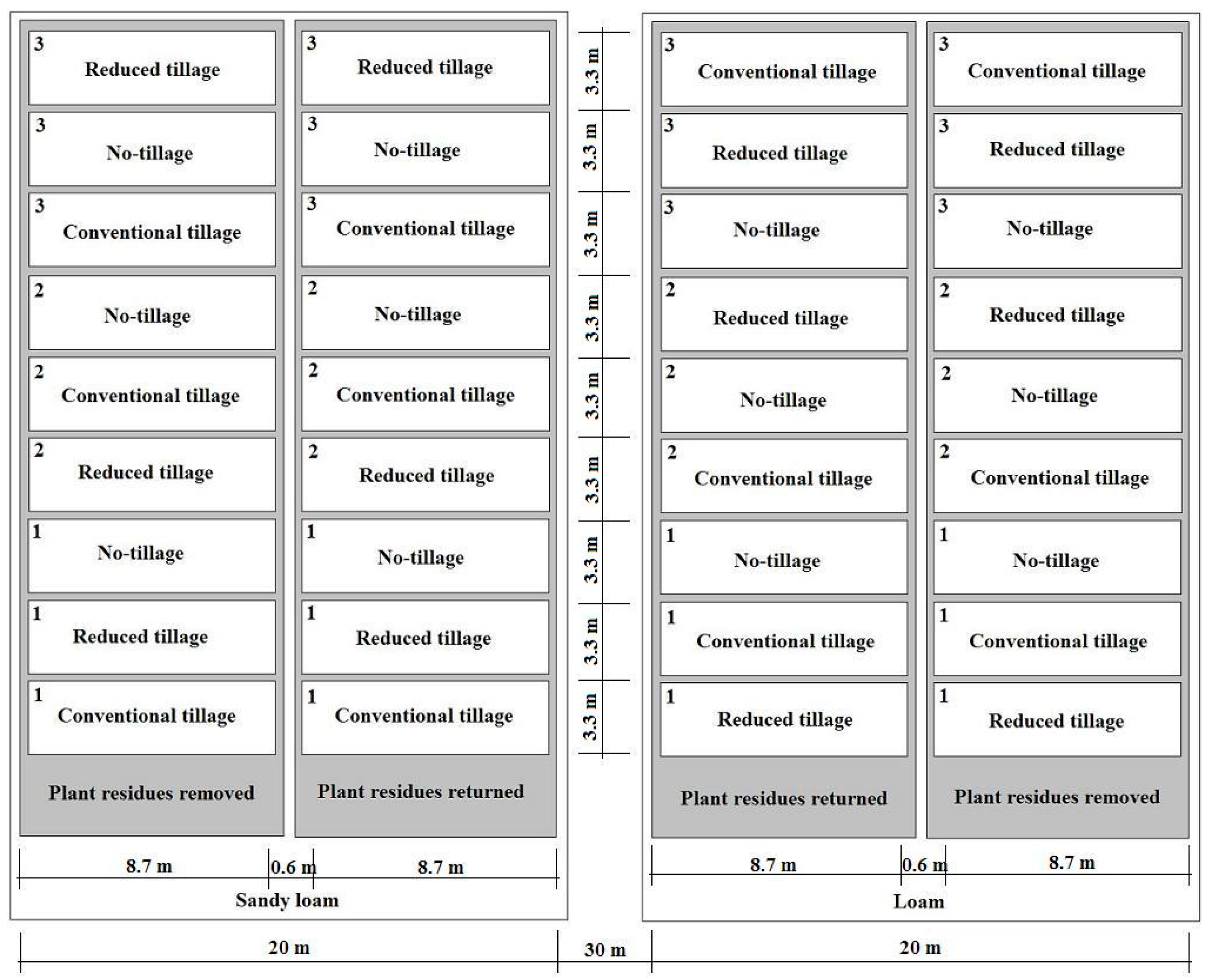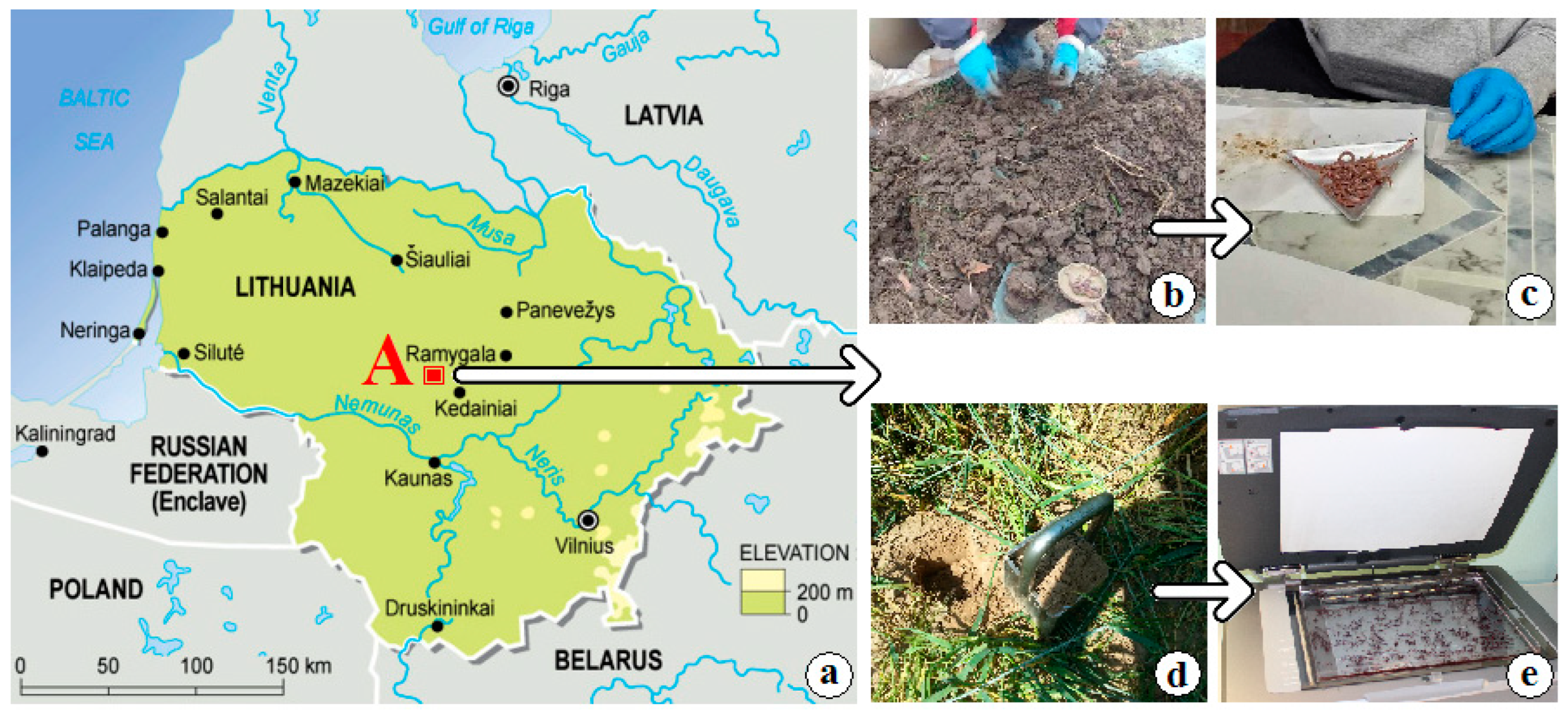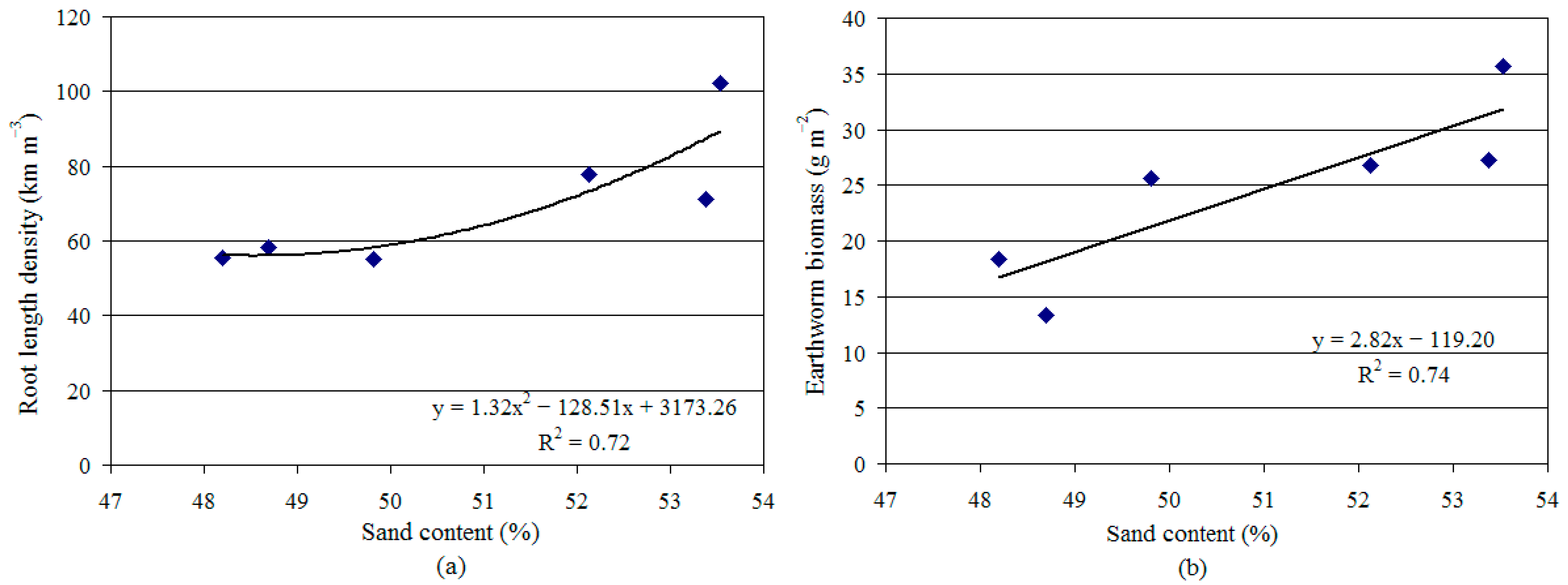Mechanism of Interaction between Earthworms and Root Parameters on Cambisol
Abstract
1. Introduction
2. Materials and Methods
2.1. Soil Description and Site
2.2. Assessments of Earthworms
2.3. Measurement of the Root System
2.4. Meteorological Conditions
2.5. Statistical Analysis
3. Results
3.1. Effect of Soil Texture, Tillage, and Residues on Root Length Density, Root Volume, and Root Diameter
3.2. Correlation between Root Characteristics in Different Tillage Systems
3.3. Effect of Soil Texture, Tillage, and Residues on Earthworm Parameters
3.4. The Effect of Earthworm Biomass on Root Parameters
3.5. The Effect of Sand Content in the Soil on Root Length Density and Earthworm Biomass
4. Discussion
5. Conclusions
Author Contributions
Funding
Data Availability Statement
Conflicts of Interest
References
- Lavelle, P.; Spain, A.; Blouin, M.; Brown, G.; Decaens, T.; Grimaldi, M.; Jimenez, J.J.; McKey, D.; Mathieu, J.; Velasquez, E.; et al. Ecosystem engineers in a self-organized soil: A review of concepts and future research questions. Soil Sci. 2016, 181, 91–109. [Google Scholar] [CrossRef]
- Van Groenigen, J.W.; Lubbers, I.M.; Vos, H.M.J.; Brown, G.G.; Deyn, G.B.D.; van Groenigen, K.J. Earthworms increase plant production: A meta-analysis. Sci. Rep. 2014, 4, 6365. [Google Scholar] [CrossRef] [PubMed]
- Bertrand, M.; Barot, S.; Bloiun, M.; Whalen, J.; de Oliveira, T.; Roger-Estrade, J. Earthworm services for cropping systems. A Review. Agron. Sustain. Dev. 2015, 35, 553–567. [Google Scholar] [CrossRef]
- Medina-Sauza, R.M.; Álvarez-Jiménez, M.; Delhal, A.; Reverchon, F.; Blouin, M.; Guerrero-Analco, J.A.; Cerdán, C.R.; Guevara, R.; Villain, L.; Barois, I. Earthworms Building up Soil Microbiota, a Review. Front. Environ. Sci. 2019, 7, 81. [Google Scholar] [CrossRef]
- Sizmur, T.; Hodson, M.E. Do earthworms impact metal mobility and availability in soil?—A review. Environ. Pollut. 2009, 157, 1981–1989. [Google Scholar] [CrossRef] [PubMed]
- Briones, M.J.I.; Bol, R. Natural abundance of 13C and 15N in earthworms from different cropping treatments: The 7th international symposium on earthworm ecology · Cardiff Wales 2002. Pedobiologia 2003, 47, 560–567. [Google Scholar] [CrossRef]
- Birkas, M.; Jolánkai, M.; Gyuricza, C.; Percze, A. Tillage effects on compaction, earthworms and other soil quality indicators in Hungary. Soil Till. Res. 2004, 78, 185–196. [Google Scholar] [CrossRef]
- Rosas-Medina, M.; Macia-Vicente, J.; Piepenbring, M. Diversity of Fungi in Soils with Different Degrees of Degradation in Germany and Panama. Mycobiology 2019, 48, 20–28. [Google Scholar] [CrossRef] [PubMed]
- Briones, M.J.I.; Schmidt, O. Conventional tillage decreases the abundance and biomass of earthworms and alters their community structure in a global meta-analysis. Glob. Chang. Biol. 2017, 23, 4396–4419. [Google Scholar] [CrossRef]
- Chan, K.Y. An overview of some tillage impacts on earthworm population abundance and diversity-implications for functioning in soils. Soil Till. Res. 2001, 57, 179–191. [Google Scholar] [CrossRef]
- Blouin, M.; Hodson, M.E.; Delgado, E.A.; Baker, G.; Brussaard, L.; Butt, K.R.; Dai, J.; Dendooven, L.; Peres, G.; Tondoh, J.E.; et al. A review of earthworm impact on soil function and ecosystem services. Eur. J. Soil Sci. 2013, 64, 161–182. [Google Scholar] [CrossRef]
- Vian, J.F.; Peigne, J.; Chaussod, R.; Roger-Estrade, J. Effects of four tillage systems on soil structure and soil microbial biomass in organic farming. Soil Use Manag. 2009, 25, 1–10. [Google Scholar] [CrossRef]
- Decaëns, T.; Margerie, P.; Aubert, M.; Hedde, M.; Bureau, F. Assembly rules within earthworm communities in North-Western France—A regional analysis. Appl. Soil Ecol. 2008, 39, 321–335. [Google Scholar] [CrossRef]
- Agapit, C.; Gigon, A.; Blouin, M. Earthworm effect on root morphology in a split root system. Plant Biosyst. 2017, 152, 780–786. [Google Scholar] [CrossRef]
- Springett, J.; Gray, R. The interaction between plant roots and earthworm burrows in pasture. Soil Biol. Biochem. 1997, 29, 621–625. [Google Scholar] [CrossRef]
- Batey, T.; McKenzie, D.C. Soil compaction: Identification directly in the field. Soil Use Manag. 2006, 22, 123–131. [Google Scholar] [CrossRef]
- Laossi, K.R.; Decaëns, T.; Jouquet, P.; Barot, S. Can we predict how earthworm effects on plant growth vary with soil properties? Appl. Environ. Soil Sci. 2010, 2010, 784342. [Google Scholar] [CrossRef]
- Laossi, K.R.; Ginot, A.; Noguera, D.C.; Blouin, M.; Barot, S. Earthworm effects on plant growth do not necessarily decrease with soil fertility. Plant Soil 2010, 328, 109–118. [Google Scholar] [CrossRef]
- Hullot, O.; Lamy, I.; Tiziani, R.; Mimmo, T.; Ciadamidaro, L. The effect of earthworms on plant response in metal contaminated soil focusing on belowground-aboveground relationships. Environ. Pollut. 2021, 274, 116499. [Google Scholar] [CrossRef]
- Jana, U.; Barot, S.; Blouin, M.; Lavelle, P.; Laffray, D.; Repellin, A. Earthworms influence the production of above- and belowground biomass and the expression of genes involved in cell proliferation and stress responses in Arabidopsis thaliana. Soil Biol. Biochem. 2010, 42, 244–252. [Google Scholar] [CrossRef]
- Capowiez, Y.; Samartino, S.; Stéphane, C.; Bouchant, P.; Richard, G.; Boizard, H. Role of earthworms in regenerating soil structure after compaction in reduced tillage systems. Soil Biol. Biochem. 2012, 55, 93–103. [Google Scholar] [CrossRef]
- Castellanos Suarez, D.E.; Gigon, A.; Puga-Freitas, R.; Lavelle, P.; Velasquez, E.; Blouin, M. Combined effects of earthworms and IAA-producing rhizobacteria on plant growth and development. Appl. Soil Ecol. 2014, 80, 100–107. [Google Scholar] [CrossRef]
- Szatanik-Kloc, A.; Horn, R.; Lipiec, J.; Siczek, A.; Szerement, J. Soil compaction-induced changes of physicochemical properties of cereal roots. Soil Till. Res. 2018, 175, 226–233. [Google Scholar] [CrossRef]
- Coulibaly, S.F.M.; Aubert, M.; Brunet, N.; Bureau, F.; Legras, M.; Chauvat, M. Short-term dynamic responses of soil properties and soil fauna under contrasting tillage systems. Soil Till. Res. 2022, 215, 105191. [Google Scholar] [CrossRef]
- Aixia, R.; Weifeng, Z.; Anwar, S.; Wen, L.; Pengcheng, D.; Ruixuan, H.; Peiru, W.; Rong, Z.; Jin, T.; Zhiqiang, G.; et al. Effects of tillage and seasonal variation of rainfall on soil water content and root growth distribution of winter wheat under rainfed conditions of the Loess Plateau, China. Agric. Water Manag. 2022, 268, 107533. [Google Scholar] [CrossRef]
- IUSS Working Group WRB. World Reference Base for Soil Resources 2014, Update 2015. International Soil Classification System for Naming Soils and Creating Legends for Soil Maps, 4th ed.; International Union of Soil Sciences (IUSS): Vienna, Austria, 2022. [Google Scholar]
- Lapinskienė, N. Ecomorphological, Quantitative and Phytocoenotic Evaluation of the Underground Organs of Grasses of the Lithuanian Agrolandscape Ecosystems. Ph.D. Thesis, Institute of Botany of Nature Research Centre, Vilnius, Lithuania, 1993; 45p. [Google Scholar]
- Bouma, T.J.; Nielsen, K.L.; Koutstaal, B.A.S. Sample preparation and scanning protocol for computerized analysis of root length and diameter. Plant Soil 2000, 218, 185–196. [Google Scholar] [CrossRef]
- Ma, L.; Shao, M.; Fan, J.; Wang, J.; Li, Y. Effects of earthworm (Metaphire guillelmi) density on soil macropore and soil water content in typical Anthrosol soil. Agric. Ecosyst. Environ. 2021, 311, 107338. [Google Scholar] [CrossRef]
- Kochiieru, M.; Lamorski, K.; Feiza, V.; Feiziene, D.; Volungevicius, J. Quantification of the relationship between root parameters and soil macropore parameters under different land use systems in Retisol. Int. Agrophys. 2020, 34, 301–308. [Google Scholar] [CrossRef]
- Ning, S.; Shi, J.; Zuo, Q.; Wang, S.; Ben-Gal, A. Generalization of the root length density distribution of cotton under film mulched drip irrigation. Field Crops Res. 2015, 177, 125–136. [Google Scholar] [CrossRef]
- Kochiieru, M.; Feiza, V.; Feizienė, D.; Volungevičius, J.; Deveikytė, I.; Seibutis, V.; Pranaitienė, S. The effect of environmental factors and root system on CO2 efflux in different types of soil and land uses. Zemdirb.-Agric. 2021, 108, 3–10. [Google Scholar] [CrossRef]
- Kochiieru, M.; Feiziene, D.; Feiza, V.; Volungevicius, J.; Velykis, A.; Slepetiene, A.; Deveikyte, I.; Seibutis, V. Freezing-thawing impact on aggregate stability as affected by land management, soil genesis and soil chemical and physical quality. Soil Till. Res. 2020, 203, 104705. [Google Scholar] [CrossRef]
- Jiang, Y.; Wang, J.; Muhammad, S.; Zhou, A.; Hao, R.; Wu, Y. How do earthworms affect decomposition of residues with different quality apart from fragmentation and incorporation? Geoderma 2018, 326, 68–75. [Google Scholar] [CrossRef]
- Kochiieru, M.; Feiza, V.; Feiziene, D.; Lamorski, K.; Deveikyte, I.; Seibutis, V.; Pranaitiene, S. Long-term contrasting tillage in Cambisol: Effect on water-stable aggregates, macropore network and soil chemical properties. Int. Agrophys. 2022, 37, 59–67. [Google Scholar] [CrossRef]









| Field | Tillage | Soil Texture Composition (%) | Texture | ||
|---|---|---|---|---|---|
| Sand >0.050 mm | Silt 0.002–0.050 mm | Clay <0.002 mm | |||
| Sandy loam | Conventional tillage | 52.1 ± 1.5 | 31.4 ± 2.8 | 16.5 ± 1.3 | Sandy loam |
| Reduced tillage | 53.5 ± 0.1 | 32.7 ± 0.5 | 13.8 ± 0.5 | Sandy loam | |
| No-tillage | 53.4 ± 1.1 | 33.7 ± 1.7 | 12.9 ± 0.7 | Sandy loam | |
| Loam | Conventional tillage | 48.7 ± 1.0 | 36.7 ± 1.9 | 14.6 ± 1.3 | Loam |
| Reduced tillage | 48.2 ± 0.5 | 36.0 ± 0.7 | 15.8 ± 0.7 | Loam | |
| No-tillage | 49.8 ± 0.5 | 36.5 ± 1.1 | 13.7 ± 1.1 | Loam | |
| Tillage | ||
|---|---|---|
| Treatment | Primary Tillage | Presowing Tillage |
| No-tillage | Glyphosate (3 L ha−1) | Direct drilling |
| Reduced tillage | Stubble cultivation (10–12 cm) + glyphosate (3 L ha−1) | Direct drilling |
| Conventional tillage | Stubble cultivation (10–12 cm) + plowing (23–25 cm) | Direct drilling |
| 2019 | Mean Air Temperature (°C) | Total Monthly Precipitation (mm) |
|---|---|---|
| January | −4.4 | 48.8 |
| February | 1.2 | 39.2 |
| March | 3.3 | 37.8 |
| April | 8.9 | 0.0 |
| May | 12.9 | 55.4 |
| June | 20.6 | 16.1 |
| July | 17.3 | 66.0 |
| August | 18.2 | 107.0 |
| September | 12.8 | 48.5 |
| October | 9.2 | 34.9 |
| November | 4.9 | 29.5 |
| December | 2.4 | 45.3 |
| Source of Variation | Df | Root Length Density | Root Volume | Root Diameter | |||
|---|---|---|---|---|---|---|---|
| F | Pr > F | F | Pr > F | F | Pr > F | ||
| Texture | 1 | 6.57 | 0.015 | 0.27 | 0.606 | 5.94 | 0.020 |
| Tillage | 2 | 0.63 | 0.541 | 0.10 | 0.902 | 1.20 | 0.313 |
| Residues | 1 | 0.80 | 0.377 | 0.35 | 0.558 | 3.03 | 0.091 |
| Tillage (Factor A) | Residues (Factor B) | Root Length Density (km m−3) | Root Volume (cm3) | Root Diameter (mm) | |||
|---|---|---|---|---|---|---|---|
| Loam | Sandy Loam | Loam | Sandy Loam | Loam | Sandy Loam | ||
| CT | 58.3 a ± 13.7 | 77.8 a ± 12.5 | 0.40 a ± 0.03 | 0.45 a ± 0.05 | 0.33 a ± 0.05 | 0.28 a ± 0.01 | |
| RT | 55.4 a ± 8.3 | 102.3 a ± 18.3 | 0.35 a ± 0.06 | 0.54 a ± 0.10 | 0.28 a ± 0.01 | 0.26 a ± 0.01 | |
| NT | 55.2 a ± 7.4 | 71.3 a ± 16.1 | 0.53 a ± 0.13 | 0.40 a ± 0.08 | 0.34 a ± 0.03 | 0.27 a ± 0.01 | |
| Removed | 52.3 a ± 8.1 | 98.1 a ± 14.3 | 0.31 b ± 0.04 | 0.53 a ± 0.07 | 0.28 a ± 0.01 | 0.27 a ± 0.01 | |
| Returned | 60.3 a ± 7.8 | 69.5 a ± 10.2 | 0.54 a ± 0.08 | 0.39 a ± 0.05 | 0.35 a ± 0.03 | 0.27 a ± 0.01 | |
| Actions and interactions: | |||||||
| A | F | 0.03 | 1.07 | 1.11 | 0.91 | 1.00 | 0.51 |
| Pr > F | 0.971 | 0.369 | 0.355 | 0.423 | 0.389 | 0.613 | |
| B | F | 0.50 | 2.67 | 6.52 | 3.06 | 4.22 | 0.01 |
| Pr > F | 0.491 | 0.122 | 0.021 | 0.100 | 0.057 | 0.970 | |
| A × B | F | 0.55 | 2.45 | 3.21 | 1.78 | 1.61 | 1.15 |
| Pr > F | 0.738 | 0.094 | 0.045 | 0.191 | 0.231 | 0.385 | |
| Tillage | Root Parameters | Range | Correlation Matrix | ||
|---|---|---|---|---|---|
| From | To | Root Volume | Root Length Density | ||
| Conventional tillage | Root diameter (mm) | 0.24 | 0.56 | −0.23 | −0.73 * |
| Root volume (cm3) | 0.27 | 0.56 | 1.00 | 0.77 ** | |
| Root length density (km m−3) | 15.5 | 121.6 | 1.00 | ||
| Reduced tillage | Root diameter (mm) | 0.24 | 0.30 | −0.08 | −0.32 |
| Root volume (cm3) | 0.17 | 0.84 | 1.00 | 0.97 ** | |
| Root length density (km m−3) | 25.8 | 154.7 | 1.00 | ||
| No-tillage | Root diameter (mm) | 0.23 | 0.47 | 0.71 * | −0.26 |
| Root volume (cm3) | 0.22 | 1.15 | 1.00 | 0.48 * | |
| Root length density (km m−3) | 29.7 | 125.1 | 1.00 | ||
| Source of Variation | Df | Earthworm (Individuals m−2) | Earthworm Biomass (g m−2) | ||
|---|---|---|---|---|---|
| F | Pr > F | F | Pr > F | ||
| Texture | 1 | 0.94 | 0.339 | 5.63 | 0.023 |
| Tillage | 2 | 1.74 | 0.192 | 0.85 | 0.438 |
| Residues | 1 | 0.11 | 0.742 | 0.01 | 0.968 |
| Tillage (Factor A) | Residues (Factor B) | Earthworm (Individuals m−2) | Earthworm Biomass (g m−2) | ||
|---|---|---|---|---|---|
| Loam | Sandy Loam | Loam | Sandy Loam | ||
| Conventional tillage | 43.3 a ± 9.3 | 64.7 a ± 12.7 | 13.4 a ± 3.1 | 26.8 a ± 6.1 | |
| Reduced tillage | 49.3 a ± 9.5 | 66.0 a ± 10.5 | 18.4 a ± 3.9 | 35.7 a ± 7.5 | |
| No-tillage | 80.0 a ± 22.1 | 74.7 a ± 13.7 | 25.7 a ± 6.8 | 27.2 a ± 4.5 | |
| Removed | 56.0 a ± 16.8 | 73.8 a ± 11.2 | 17.8 a ± 5.2 | 31.4 a ± 5.9 | |
| Returned | 59.1 a ± 7.6 | 63.1 a ± 8.0 | 20.4 a ± 2.8 | 28.4 a ± 4.0 | |
| Actions and interactions: | |||||
| A | F | 1.75 | 0.19 | 1.61 | 0.67 |
| Pr > F | 0.207 | 0.827 | 0.232 | 0.527 | |
| B | F | 0.03 | 0.60 | 0.19 | 0.18 |
| Pr > F | 0.868 | 0.449 | 0.668 | 0.679 | |
| A × B | F | 1.06 | 0.81 | 0.94 | 0.54 |
| Pr > F | 0.430 | 0.563 | 0.487 | 0.745 | |
Disclaimer/Publisher’s Note: The statements, opinions and data contained in all publications are solely those of the individual author(s) and contributor(s) and not of MDPI and/or the editor(s). MDPI and/or the editor(s) disclaim responsibility for any injury to people or property resulting from any ideas, methods, instructions or products referred to in the content. |
© 2024 by the authors. Licensee MDPI, Basel, Switzerland. This article is an open access article distributed under the terms and conditions of the Creative Commons Attribution (CC BY) license (https://creativecommons.org/licenses/by/4.0/).
Share and Cite
Kochiieru, M.; Veršulienė, A.; Shatkovska, K.; Feiza, V.; Seibutis, V. Mechanism of Interaction between Earthworms and Root Parameters on Cambisol. Agronomy 2024, 14, 1536. https://doi.org/10.3390/agronomy14071536
Kochiieru M, Veršulienė A, Shatkovska K, Feiza V, Seibutis V. Mechanism of Interaction between Earthworms and Root Parameters on Cambisol. Agronomy. 2024; 14(7):1536. https://doi.org/10.3390/agronomy14071536
Chicago/Turabian StyleKochiieru, Mykola, Agnė Veršulienė, Kateryna Shatkovska, Virginijus Feiza, and Vytautas Seibutis. 2024. "Mechanism of Interaction between Earthworms and Root Parameters on Cambisol" Agronomy 14, no. 7: 1536. https://doi.org/10.3390/agronomy14071536
APA StyleKochiieru, M., Veršulienė, A., Shatkovska, K., Feiza, V., & Seibutis, V. (2024). Mechanism of Interaction between Earthworms and Root Parameters on Cambisol. Agronomy, 14(7), 1536. https://doi.org/10.3390/agronomy14071536







